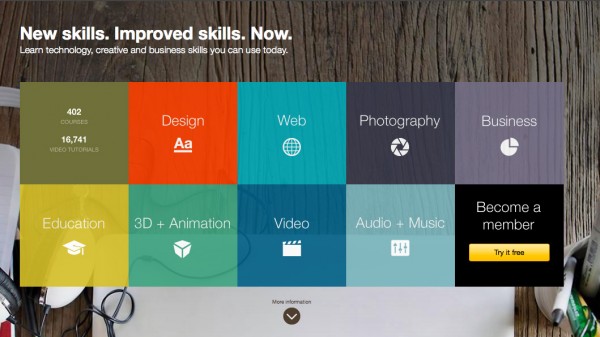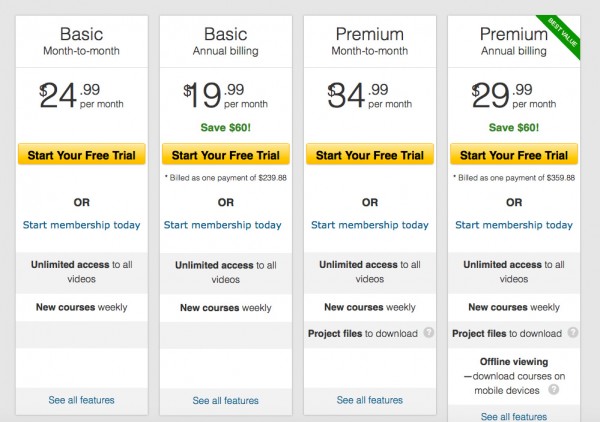This is one of the fastest-growing business models on the Internet
A classroom website organizes a series of courses for paid members that is updated regularly.
Back in the dark days before the Internet, many publishers thrived by producing newsletter or looseleaf print training services that were typically membership based. Today, those print training newsletters have been replaced by the classroom website business model, now with the ability to not only produce their own training videos and other 21st-century materials, but to create custom portals for corporations to produce their materials and upload them.
That makes this website example a hot one these days. Most of them cater to the B2B market, but, as we’ll see in a moment, the well-known mass media site we consider a mentor, Lynda.com, now owned by LinkedIn, includes many classes that appeal to consumers and hobbyists. The Mequoda niche mentor site, Leadercast, is strictly a B2B site, with its focus on training leaders. Media giant Lynda, of course, has its own leadership courses — 58 of them — under its business category, but also offers hundreds of courses that would appeal to hobbyists as well as professionals in website development, photography, audio and music, and video production.
[text_ad]
Examples of classroom website business models
Leadercast, which only recently launched a shiny new Mequoda website, offers a robust premium content membership called Leadercast Now in which members can watch short videos of respected world leaders from all walks of life and business discussing strategies, techniques and principles of leadership.
Members can also track videos they’ve watched, videos they plan to watch, and their own progress at executing a range of hands-on exercises to reinforce learning in a personal dashboard called the Activity Manager.
This training is available as a membership; Leadercast offers a monthly plan for $29.97/mo or $299 per year. Leadercast supplements this ongoing, daily training with an annual Leadercast Live event, which is also simulcast in a variety of cities.
Leadercast’s home page offers a rotating promotion for its various products. Scroll down a bit further and you’ll find images and brief descriptions of each product plus another promotion for Leadercast Live.
Leadercast, like many other website business models, offers free content to entice visitors to become members. The featured video is available free for 24 hours. Other content is splashed on the page just below the featured video, each titled with its core theme and showing the viewer how many times it’s been watched and how many other members have marked it as a favorite.
Leadercast further monetizes its website by selling sponsorships, allowing their partners to produce their own content.
Lynda.com, with its 3,715 courses, displays its various categories and, if you hover over each, it displays the number of courses and video tutorials in each on its home page.
Lynda also offers free content, this time in the form of a free trial. Like many publishers, Lynda asks for the credit card up front and the member will become a paid member after 10 days if he or she doesn’t cancel. Unlike Leadercast, Lynda offers several different membership options, with more bells and whistles available the more you spend.
Characteristics of a classroom website business model
Surprisingly, the classroom membership website model shares quite a few characteristics with its fellow premium membership website model, the magazine website. It has little in common with any of the other website business models, free or premium.
| Who Pays | MIU | Frequency | % UGC | Authors | Browse/Search | Homepage | Video | |
| FREE (AFFINITY) | ||||||||
| Portal | Sponsor | Post | High | Moderate | Many | Search | Varies | Sometimes |
| Directory | Sponsor | Listing | High | Low | Many | Browse | What’s new | Sometimes |
| Community | Varies | User profile | High | High | Many | Search | Varies | Sometimes |
| Lead Gen | Sponsor | Free product | Low | Low | Many | Browse | Varies | Sometimes |
| PAID (PREMIUM) | ||||||||
| Magazine | Varies | Article | Low | Low | Many | Browse | What’s new | Sometimes |
| Newsletter | User | Article | Low | Low | Few | Browse | What’s new | Sometimes |
| Library | Varies | Record | N/A | Low | Many | Search | What’s Popular | Sometimes |
| Classroom | User | Lesson or course | Low | Low | Many | Browse | Varies | Always |
| Event | Hybrid | Single event | Low | Low | Low | Browse | What’s new | Sometimes |
| Retail | User | Product | High | High | Many | Browse | Varies | Sometimes |
Who pays: The user pays for courses, whether that’s an individual or a company.
MIU: The minimum information unit of a classroom website is lesson or course — a single course or collection of lessons or activities that the user can mix and match to create his or her own course.
Frequency: Publishing frequency at a classroom site is relatively low. Leadercast’s frequency is closer to what we’d call medium, promoting three new videos per day, but then again, some of those are evergreen blockbusters that aren’t newly produced. The cost to produce this kind of content, ranging from $100 to $1,000 per minute, is behind this generally low publication frequency.
User-generated content: User-generated content is fairly low; in fact, the only such content is whatever a member creates to complete a course.
Number of authors: There are many authors at a classroom site, given that most experts are limited to one topic. Both Leadercast and Lynda have multitudes of speakers and contributors in order to cover as much subject matter as possible.
Browse or Search: At a classroom site, the user browses through lists of courses organized by subject matter, such as “Decision Making” or “Leadership Principles” at Leadercast, or “Business” or “Education” at Lynda.
Home page: The home page of a classroom site varies with each publisher. Leadercast, for example, posts a new featured video every day, while Lynda’s home page offers the list of subjects that are popular with its users.
Video: Unlike all the other website business models, the classroom site always offers video, for obvious reasons.
With the classroom site taking off in the Internet age, we’d love to hear from other publishers who run them. For that matter, perhaps you’ve been thinking of taking your stable of subject matter experts into the recording studio in order to launch such a site. Either way, let us know in the comments, and if you have any questions or insight on this model, let’s hear them.







